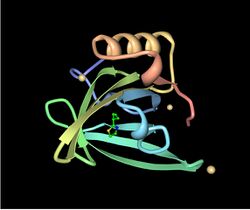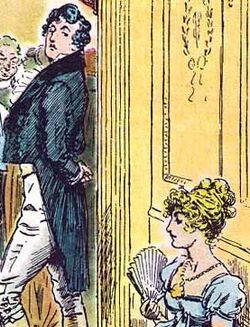Biology:Major urinary proteins
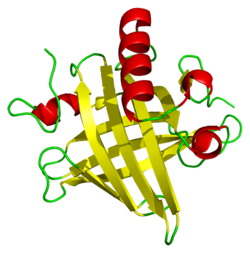
Major urinary proteins (Mups), also known as α2u-globulins, are a subfamily of proteins found in abundance in the urine and other secretions of many animals. Mups provide a small range of identifying information about the donor animal, when detected by the vomeronasal organ of the receiving animal. They belong to a larger family of proteins known as lipocalins. Mups are encoded by a cluster of genes, located adjacent to each other on a single stretch of DNA, that varies greatly in number between species: from at least 21 functional genes in mice to none in humans. Mup proteins form a characteristic glove shape, encompassing a ligand-binding pocket that accommodates specific small organic chemicals.
Urinary proteins were first reported in rodents in 1932, during studies by Thomas Addis into the cause of proteinuria. They are potent human allergens and are largely responsible for a number of animal allergies, including to cats, horses and rodents. Their endogenous function within an animal is unknown but may involve regulating energy expenditure. However, as secreted proteins they play multiple roles in chemical communication between animals, functioning as pheromone transporters and stabilizers in rodents and pigs. Mups can also act as protein pheromones themselves. They have been demonstrated to promote aggression in male mice, and one specific Mup protein found in male mouse urine is sexually attractive to female mice. Mups can also function as signals between different species: mice display an instinctive fear response on the detection of Mups derived from predators such as cats and rats.
Discovery
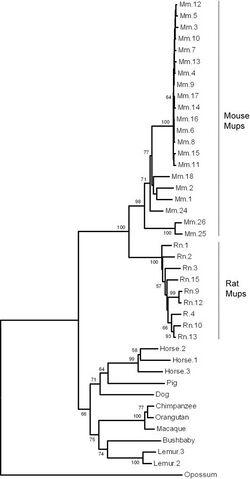
Humans in good health excrete urine that is largely free of protein. Therefore, since 1827 physicians and scientists have been interested in proteinuria, the excess of protein in human urine, as an indicator of kidney disease.[notes 1][2] To better understand the etiology of proteinuria, some scientists attempted to study the phenomenon in laboratory animals.[3] Between 1932 and 1933 a number of scientists, including Thomas Addis, independently reported the surprising finding that some healthy rodents have protein in their urine.[4][5][6] However, it was not until the 1960s that the major urinary proteins of mice and rats were first described in detail.[7][8] It was found that the proteins are primarily made in the liver of males and secreted through the kidneys into the urine in large quantities (milligrams per day).[7][8][9]
Since they were named, the proteins have been found to be differentially expressed in other glands that secrete products directly into the external environment. These include lacrimal, parotid, submaxillary, sublingual, preputial and mammary glands.[10][11][12] In some species, such as cats and pigs, Mups appear not to be expressed in urine at all and are mainly found in saliva.[13][14] Sometimes the term urinary Mups (uMups) is used to distinguish those Mups expressed in urine from those in other tissues.[15]
Mup genes
Between 1979 and 1981, it was estimated that Mups are encoded by a gene family of between 15 and 35 genes and pseudogenes in the mouse and by an estimated 20 genes in the rat.[16][17][18] In 2008 a more precise number of Mup genes in a range of species was determined by analyzing the DNA sequence of whole genomes.[1][19]
Rodents
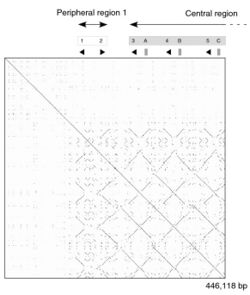
The mouse reference genome has at least 21 distinct Mup genes (with open reading frames) and a further 21 Mup pseudogenes (with reading frames disrupted by a nonsense mutation or an incomplete gene duplication). They are all clustered together, arrayed side by side across 1.92 megabases of DNA on chromosome 4. The 21 functional genes have been divided into two sub-classes based on position and sequence similarity: 6 peripheral Class A Mups and 15 central Class B Mups.[1][20] The central Class B Mup gene cluster formed through a number of sequential duplications from one of the Class A Mups. As all the Class B genes are almost identical to each other, researchers have concluded that these duplications occurred very recently in mouse evolution. Indeed, the repetitive structure of these central Mup genes means they are likely to be unstable and may vary in number among wild mice.[20] The Class A Mups are more different from each other and are therefore likely to be more stable, older genes, but what, if any, functional differences the classes have are unknown.[1] The similarity between the genes makes the region difficult to study using current DNA sequencing technology. Consequently, the Mup gene cluster is one of the few parts of the mouse whole genome sequence with gaps remaining, and further genes may remain undiscovered.[1][20]
Rat urine also contains homologous urinary proteins; although they were originally given a different name, α2u-globulins,[8][9] they have since become known as rat Mups.[21][22] Rats have 9 distinct Mup genes and a further 13 pseudogenes clustered together across 1.1 megabases of DNA on chromosome 5. Like in mice, the cluster formed by multiple duplications. However, this occurred independently of the duplications in mice, meaning that both rodent species expanded their Mup gene families separately, but in parallel.[1][23]
Nonrodents
Most other mammals studied, including the pig, cow, cat, dog, bushbaby, macaque, chimpanzee and orangutan, have a single Mup gene. Some, however, have an expanded number: horses have three Mup genes, and gray mouse lemurs have at least two. Insects, fish, amphibia, birds and marsupials appear to have disrupted synteny at the chromosomal position of the Mup gene cluster, suggesting the gene family may be specific to placental mammals.[1] Humans are the only placental mammals found not to have any active Mup genes; instead, they have a single Mup pseudogene containing a mutation that causes missplicing, rendering it dysfunctional.[1]
Function
Transport proteins
Mups are members of a large family of low-molecular weight (~19 kDa) proteins known as lipocalins.[25] They have a characteristic structure of eight beta sheets arranged in an anti-parallel beta barrel open on one face, with alpha helices at both ends.[25] Consequently, they form a characteristic glove shape, encompassing a cup-like pocket that binds small organic chemicals with high affinity.[1][26] A number of these ligands bind to mouse Mups, including 2-sec-butyl-4,5-dihydrothiazole (abbreviated as SBT or DHT), 6-hydroxy-6-methyl-3-heptanone (HMH) and 2,3 dihydro-exo-brevicomin (DHB).[27][28][29] These are all urine-specific chemicals that have been shown to act as pheromones—molecular signals excreted by one individual that trigger an innate behavioural response in another member of the same species.[27][30] Mouse Mups have also been shown to function as pheromone stabilizers, providing a slow release mechanism that extends the potency of volatile pheromones in male urine scent marks.[31] Given the diversity of Mups in rodents, it was originally thought that different Mups may have differently shaped binding pockets and therefore bind different pheromones. However, detailed studies found that most variable sites are located on the surface of the proteins and appear to have little effect on ligand binding.[32]
Rat Mups bind different small chemicals. The most common ligand is 1-Chlorodecane, with 2-methyl-N-phenyl-2-propenamide, hexadecane and 2,6,11-trimethyl decane found to be less prominent.[33] Rat Mups also bind limonene-1,2-epoxide, resulting in a disease of the host's kidney, hyaline-droplet nephropathy, that progresses to cancer. Other species do not develop this disorder because their Mups do not bind that particular chemical.[34] Accordingly, when transgenic mice were engineered to express the rat Mup, their kidneys developed the disease.[35] The Mup found in pigs, named salivary lipocalin (SAL), is expressed in the salivary gland of males where it tightly binds androstenone and androstenol, both pheromones that cause female pigs to assume a mating stance.[1][14]
Isothermal titration calorimetry studies performed with Mups and associated ligands (pyrazines,[36][37] alcohols,[38][39] thiazolines,[40][28] 6-hydroxy-6-methyl-3-heptanone,[41] and N-phenylnapthylamine,[42][43]) revealed an unusual binding phenomena. The active site has been found to be suboptimally hydrated, resulting in ligand binding being driven by enthalpic dispersion forces. This is contrary to most other proteins, which exhibit entropy-driven binding forces from the reorganisation of water molecules. This unusual process has been termed the nonclassical hydrophobic effect.[43]
Pheromones
Studies have sought to find the precise function of Mups in pheromone communication. Mup proteins have been shown to promote puberty and accelerate the estrus cycle in female mice, inducing the Vandenbergh and Whitten effects.[38][44] However, in both cases the Mups had to be presented to the female dissolved in male urine, indicating that the protein requires some urinary context to function. In 2007 Mups normally found in male mouse urine were made in transgenic bacteria, and therefore created devoid of the chemicals they normally bind. These Mups were shown to be sufficient to promote aggressive behaviour in males, even in the absence of urine.[19] In addition, Mups made in bacteria were found to activate olfactory sensory neurons in the vomeronasal organ (VNO), a subsystem of the nose known to detect pheromones via specific sensory receptors, of mice and rats.[19][45] Together, this demonstrated that Mup proteins can act as pheromones themselves, independent of their ligands.[46]
Consistent with a role in male-male aggression, adult male mice secrete significantly more Mups into their urine than females, juveniles or castrated male mice. The precise mechanism driving this difference between the sexes is complex, but at least three hormones—testosterone, growth hormone and thyroxine—are known to positively influence the production of Mups in mice.[47] Wild house mouse urine contains variable combinations of four to seven distinct Mup proteins per mouse.[48] Some inbred laboratory mouse strains, such as BALB/c and C57BL/6, also have different proteins expressed in their urine.[20] However, unlike wild mice, different individuals from the same strain express the same protein pattern, an artifact of many generations of inbreeding.[49][50] One unusual Mup is less variable than the others: it is consistently produced by a high proportion of wild male mice and is almost never found in female urine. When this Mup was made in bacteria and used in behavioural testing, it was found to attract female mice. Other Mups were tested but did not have the same attractive qualities, suggesting the male-specific Mup acts as a sex pheromone.[51] Scientists named this Mup darcin (Mup20, Q5FW60) as a humorous reference to Fitzwilliam Darcy, the romantic hero from Pride and Prejudice.[52][53] Taken together, the complex patterns of Mups produced has the potential to provide a range of information about the donor animal, such as gender, fertility, social dominance, age, genetic diversity or kinship.[19][54][55] Wild mice (unlike laboratory mice that are genetically identical and which therefore also have identical patterns of Mups in the urine) have individual patterns of Mup expression in their urine that act as a "barcode" to uniquely identify the owner of a scent mark.[54]
In the house mouse, the major MUP gene cluster provides a highly polymorphic scent signal of genetic identity. Wild mice breeding freely in semi-natural enclosures showed inbreeding avoidance. This avoidance resulted from a strong deficit in successful matings between mice sharing both MUP haplotypes (complete match).[56] In another study, using white-footed mice, it was found that when mice derived from wild populations were inbred, there was reduced survival when such mice were reintroduced into a natural habitat.[57] These findings suggest that inbreeding reduces fitness, and that scent signal recognition has evolved in mice as a means of avoiding inbreeding depression.
Kairomones
In addition to serving as social cues between members of the same species, Mups can act as kairomones—chemical signals that transmit information between species.[58][59][60] Mice are instinctively afraid of the smell of their natural predators, including cats and rats. This occurs even in laboratory mice that have been isolated from predators for hundreds of generations.[61] When the chemical cues responsible for the fear response were purified from cat saliva and rat urine, two homologous protein signals were identified: Fel d 4 (Felis domesticus allergen 4; Q5VFH6), the product of the cat Mup gene, and Rat n 1 (Rattus norvegicus allergen 1; P02761), the product of the rat Mup13 gene.[59] Mice are fearful of these Mups even when they are made in bacteria, but mutant animals that are unable to detect the Mups showed no fear of rats, demonstrating their importance in initiating fearful behaviour.[58][62] It is not known exactly how Mups from different species initiate disparate behaviours, but mouse Mups and predator Mups have been shown to activate unique patterns of sensory neurons in the nose of recipient mice. This implies the mouse perceives them differently, via distinct neural circuits.[58][59] The pheromone receptors responsible for Mup detection are also unknown, though they are thought be members of the V2R receptor class.[19][59]
Allergens
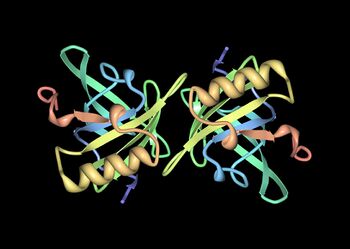
Along with other members of the lipocalin protein family, major urinary proteins can be potent allergens to humans.[64] The reason for this is not known; however, molecular mimicry between Mups and structurally similar human lipocalins has been proposed as a possible explanation.[65] The protein product of the mouse Mup6 and Mup2 genes (previously mistaken as Mup17 due to the similarity among mouse MUPs), known as Mus m 1, Ag1 or MA1,[66] accounts for much of the allergenic properties of mouse urine.[1][67] The protein is extremely stable in the environment; studies have found 95% of inner city homes and 82% of all types of homes in the United States have detectable levels in at least one room.[68][69] Similarly, Rat n 1 is a known human allergen.[64] A US study found its presence in 33% of inner city homes, and 21% of occupants were sensitized to the allergen.[70] Exposure and sensitization to rodent Mup proteins is considered a risk factor for childhood asthma and is a leading cause of laboratory animal allergy (LAA)—an occupational disease of laboratory animal technicians and scientists.[71][72][73][74] One study found that two-thirds of laboratory workers who had developed asthmatic reactions to animals had antibodies to Rat n 1.[75]
Mup genes from other mammals also encode allergenic proteins, for example Fel d 4 is primarily produced in the submandibular salivary gland and is deposited onto dander as the cat grooms itself. A study found that 63% of cat allergic people have antibodies against the protein. Most had higher titres of antibodies against Fel d 4 than against Fel d 1, another prominent cat allergen.[13] Likewise, Equ c 1 (Equus caballus allergen 1; Q95182) is the protein product of a horse Mup gene that is found in the liver, sublingual and submaxillary salivary glands.[1][76] It is responsible for about 80% of the antibody response in patients who are chronically exposed to horse allergens.[76]
Metabolism
While the detection of Mups excreted by other animals has been well studied, the functional role in the producing animal is less clear. However, in 2009, Mups were shown to be associated with the regulation of energy expenditure in mice. Scientists found that genetically induced obese, diabetic mice produce thirty times less Mup RNA than their lean siblings.[77] When they delivered Mup protein directly into the bloodstream of these mice, they observed an increase in energy expenditure, physical activity and body temperature and a corresponding decrease in glucose intolerance and insulin resistance. They propose that Mups' beneficial effects on energy metabolism occurs by enhancing mitochondrial function in skeletal muscle.[77] Another study found Mups were reduced in diet-induced obese mice. In this case, the presence of Mups in the bloodstream of mice restricted glucose production by directly inhibiting the expression of genes in the liver.[78]
See also
- Cis-vaccenyl acetate, an insect aggression pheromone
- Major histocompatibility complex, peptides also implicated in individual recognition in mice
- Proteins produced and secreted by the liver
Notes
- ↑ In that year Richard Bright first related kidney disease, later to become known as Bright's disease, with albuminous urine.
References
- ↑ Jump up to: 1.00 1.01 1.02 1.03 1.04 1.05 1.06 1.07 1.08 1.09 1.10 1.11 "Species specificity in major urinary proteins by parallel evolution". PLOS ONE 3 (9): e3280. September 2008. doi:10.1371/journal.pone.0003280. PMID 18815613. Bibcode: 2008PLoSO...3.3280L.
- ↑ "Disease-dependent mechanisms of albuminuria". American Journal of Physiology. Renal Physiology 295 (6): F1589-600. December 2008. doi:10.1152/ajprenal.00142.2008. PMID 18579704.
- ↑ "Thomas Addis: 1881–1949". Biographical Memoirs of the National Academy of Sciences 63: 1–46. 1994. http://books.nap.edu/openbook.php?record_id=4560&page=3.
- ↑ "Proteinuria and cylinduria". Proceedings of the California Academy of Sciences 2: 38–52. 1932.
- ↑ "Albuminuria in the normal male rat". The Journal of Physiology 79 (2): 191–3. September 1933. doi:10.1113/jphysiol.1933.sp003040. PMID 16994453.
- ↑ "The Composition of the Urine of White Mice". The Journal of Biological Chemistry 100 (2): 551–55. 1933. doi:10.1016/S0021-9258(18)75972-3. http://www.jbc.org/content/100/2/557.full.pdf+html.
- ↑ Jump up to: 7.0 7.1 "Major urinary protein complex of normal mice: origin". Science 149 (3687): 981–2. August 1965. doi:10.1126/science.149.3687.981. PMID 5827345. Bibcode: 1965Sci...149..981F.
- ↑ Jump up to: 8.0 8.1 8.2 "Identification of rat urinary proteins by zone and immunoelectrophoresis". Proceedings of the Society for Experimental Biology and Medicine 121 (3): 894–9. March 1966. doi:10.3181/00379727-121-30917. PMID 4160706.
- ↑ Jump up to: 9.0 9.1 "Proof of the hepatic synthesis of a sex-dependent protein in the rat". Biochimica et Biophysica Acta (BBA) - General Subjects 127 (1): 82–7. September 1966. doi:10.1016/0304-4165(66)90478-8. PMID 4165835.
- ↑ "Rat alpha 2u-globulin mRNA expression in the preputial gland". Biochemical Genetics 23 (3–4): 281–90. April 1985. doi:10.1007/BF00504325. PMID 2409959.
- ↑ "Differential regulation of alpha 2u globulin gene expression in liver, lachrymal gland, and salivary gland". The Journal of Biological Chemistry 259 (20): 12803–9. October 1984. doi:10.1016/S0021-9258(18)90817-3. PMID 6208189.
- ↑ "Expression of six mouse major urinary protein genes in the mammary, parotid, sublingual, submaxillary, and lachrymal glands and in the liver". Molecular and Cellular Biology 7 (5): 1947–54. May 1987. doi:10.1128/MCB.7.5.1947. PMID 3600653.
- ↑ Jump up to: 13.0 13.1 "Fel d 4, a cat lipocalin allergen". Clinical and Experimental Allergy 34 (11): 1732–8. November 2004. doi:10.1111/j.1365-2222.2004.02090.x. PMID 15544598.
- ↑ Jump up to: 14.0 14.1 "Cloning, post-translational modifications, heterologous expression and ligand-binding of boar salivary lipocalin". The Biochemical Journal 350 Pt 2 (Pt 2): 369–79. September 2000. doi:10.1042/0264-6021:3500369. PMID 10947950.
- ↑ "Multiple roles of major urinary proteins in the house mouse, Mus domesticus". Biochemical Society Transactions 31 (Pt 1): 142–6. February 2003. doi:10.1042/BST0310142. PMID 12546672.
- ↑ "Rat alpha 2u globulin is encoded by a multigene family". Journal of Molecular and Applied Genetics 1 (1): 29–38. 1981. PMID 6180115.
- ↑ "Multiple genes coding for the androgen-regulated major urinary proteins of the mouse". Cell 17 (2): 449–57. June 1979. doi:10.1016/0092-8674(79)90171-5. PMID 88267.
- ↑ "Two main groups of mouse major urinary protein genes, both largely located on chromosome 4". The EMBO Journal 1 (5): 615–20. 1982. doi:10.1002/j.1460-2075.1982.tb01217.x. PMID 6329695.
- ↑ Jump up to: 19.0 19.1 19.2 19.3 19.4 "Identification of protein pheromones that promote aggressive behaviour". Nature 450 (7171): 899–902. December 2007. doi:10.1038/nature05997. PMID 18064011. Bibcode: 2007Natur.450..899C.
- ↑ Jump up to: 20.0 20.1 20.2 20.3 20.4 "Dynamic instability of the major urinary protein gene family revealed by genomic and phenotypic comparisons between C57 and 129 strain mice". Genome Biology 9 (5): R91. 2008. doi:10.1186/gb-2008-9-5-r91. PMID 18507838.
- ↑ Urinary Lipocalins in Rodenta:is there a Generic Model?. Chemical Signals in Vertebrates 11. Springer New York. 2007. ISBN 978-0-387-73944-1.
- ↑ "Major urinary proteins, alpha(2U)-globulins and aphrodisin". Biochimica et Biophysica Acta (BBA) - Protein Structure and Molecular Enzymology 1482 (1–2): 218–28. October 2000. doi:10.1016/S0167-4838(00)00149-7. PMID 11058763.
- ↑ "Genomic organization of the rat alpha 2u-globulin gene cluster". Mammalian Genome 10 (5): 463–70. May 1999. doi:10.1007/s003359901024. PMID 10337619.
- ↑ "Pheromone binding to two rodent urinary proteins revealed by X-ray crystallography". Nature 360 (6400): 186–8. November 1992. doi:10.1038/360186a0. PMID 1279439. Bibcode: 1992Natur.360..186B.
- ↑ Jump up to: 25.0 25.1 "The lipocalin protein family: structure and function". The Biochemical Journal 318 ( Pt 1) (1): 1–14. August 1996. doi:10.1042/bj3180001. PMID 8761444.
- ↑ "A phylogenetic analysis of the lipocalin protein family". Molecular Biology and Evolution 17 (1): 114–26. January 2000. doi:10.1093/oxfordjournals.molbev.a026224. PMID 10666711.
- ↑ Jump up to: 27.0 27.1 "Structure and function of the vomeronasal system: an update". Progress in Neurobiology 70 (3): 245–318. June 2003. doi:10.1016/S0301-0082(03)00103-5. PMID 12951145. https://pdfs.semanticscholar.org/22f2/53336dbce6de5378b9733023db8a4ed70aa4.pdf.
- ↑ Jump up to: 28.0 28.1 "Structural basis of pheromone binding to mouse major urinary protein (MUP-I)". Protein Science 10 (5): 997–1004. May 2001. doi:10.1110/ps.52201. PMID 11316880.
- ↑ "Structural and functional differences in isoforms of mouse major urinary proteins: a male-specific protein that preferentially binds a male pheromone". The Biochemical Journal 391 (Pt 2): 343–50. October 2005. doi:10.1042/BJ20050404. PMID 15934926.
- ↑ "What is a pheromone? Mammalian pheromones reconsidered". Neuron 46 (5): 699–702. June 2005. doi:10.1016/j.neuron.2005.04.032. PMID 15924856.
- ↑ "Proteins in urine scent marks of male house mice extend the longevity of olfactory signals". Animal Behaviour 55 (5): 1289–97. May 1998. doi:10.1006/anbe.1997.0650. PMID 9632512.
- ↑ "Effect of polymorphisms on ligand binding by mouse major urinary proteins". Protein Science 10 (2): 411–7. February 2001. doi:10.1110/ps.31701. PMID 11266626.
- ↑ "Identification of alpha2u-globulin and bound volatiles in the Indian common house rat (Rattus rattus)". Indian Journal of Biochemistry & Biophysics 46 (4): 319–24. August 2009. PMID 19788064.
- ↑ "Biochemical basis for mouse resistance to hyaline droplet nephropathy: lack of relevance of the alpha 2u-globulin protein superfamily in this male rat-specific syndrome". Toxicology and Applied Pharmacology 112 (2): 214–21. February 1992. doi:10.1016/0041-008X(92)90190-4. PMID 1371614.
- ↑ "d-Limonene induced hyaline droplet nephropathy in alpha 2u-globulin transgenic mice". Fundamental and Applied Toxicology 23 (4): 562–8. November 1994. doi:10.1006/faat.1994.1141. PMID 7532604.
- ↑ "Thermodynamics of binding of 2-methoxy-3-isopropylpyrazine and 2-methoxy-3-isobutylpyrazine to the major urinary protein". Journal of the American Chemical Society 126 (6): 1675–81. February 2004. doi:10.1021/ja038461i. PMID 14871097.
- ↑ "Van der Waals interactions dominate ligand-protein association in a protein binding site occluded from solvent water". Journal of the American Chemical Society 127 (33): 11827–34. August 2005. doi:10.1021/ja0527525. PMID 16104761.
- ↑ Jump up to: 38.0 38.1 "Acceleration of puberty onset in female mice by male urinary proteins". The Journal of Physiology 486 ( Pt 2) (Pt 2): 517–22. July 1995. doi:10.1113/jphysiol.1995.sp020830. PMID 7473215.
- ↑ "Strong solute-solute dispersive interactions in a protein-ligand complex". Journal of the American Chemical Society 127 (48): 17061–7. December 2005. doi:10.1021/ja055454g. PMID 16316253.
- ↑ "Thermodynamic analysis of binding between mouse major urinary protein-I and the pheromone 2-sec-butyl-4,5-dihydrothiazole". Biochemistry 42 (20): 6302–9. May 2003. doi:10.1021/bi026423q. PMID 12755635.
- ↑ "Thermodynamic consequences of disrupting a water-mediated hydrogen bond network in a protein:pheromone complex". Protein Science 14 (1): 249–56. January 2005. doi:10.1110/ps.04912605. PMID 15608125.
- ↑ "The binding cavity of mouse major urinary protein is optimised for a variety of ligand binding modes". Biochemical and Biophysical Research Communications 390 (4): 1266–71. December 2009. doi:10.1016/j.bbrc.2009.10.133. PMID 19878650.
- ↑ Jump up to: 43.0 43.1 "Water, water everywhere--except where it matters?". Drug Discovery Today 12 (13–14): 534–9. July 2007. doi:10.1016/j.drudis.2007.05.004. PMID 17631247.
- ↑ "Stimulation of estrus in female mice by male urinary proteins". Journal of Chemical Ecology 26 (10): 2355–65. 2000. doi:10.1023/A:1005578911652.
- ↑ "Selective activation of G protein subtypes in the vomeronasal organ upon stimulation with urine-derived compounds". The Journal of Biological Chemistry 274 (8): 4655–62. February 1999. doi:10.1074/jbc.274.8.4655. PMID 9988702.
- ↑ "Aggression protein found in mice". BBC News. 5 December 2007. http://news.bbc.co.uk/2/hi/science/nature/7129176.stm.
- ↑ "Differential, multihormonal regulation of the mouse major urinary protein gene family in the liver". Molecular and Cellular Biology 3 (12): 2232–40. December 1983. doi:10.1128/MCB.3.12.2232. PMID 6656765.
- ↑ "Molecular heterogeneity of urinary proteins in wild house mouse populations". Rapid Communications in Mass Spectrometry 11 (7): 786–90. 1997. doi:10.1002/(SICI)1097-0231(19970422)11:7<786::AID-RCM876>3.0.CO;2-8. PMID 9161047. Bibcode: 1997RCMS...11..786R.
- ↑ "Molecular heterogeneity in the Major Urinary Proteins of the house mouse Mus musculus". The Biochemical Journal 316 ( Pt 1) (Pt 1): 265–72. May 1996. doi:10.1042/bj3160265. PMID 8645216.
- ↑ "Limited variation in the major urinary proteins of laboratory mice". Physiology & Behavior 96 (2): 253–61. February 2009. doi:10.1016/j.physbeh.2008.10.005. PMID 18973768.
- ↑ "On the scent of sexual attraction". BMC Biology 8 (1): 71. June 2010. doi:10.1186/1741-7007-8-71. PMID 20504292.
- ↑ "Darcin: a male pheromone that stimulates female memory and sexual attraction to an individual male's odour". BMC Biology 8 (1): 75. June 2010. doi:10.1186/1741-7007-8-75. PMID 20525243.
- ↑ "Biologists Learn Why Mice Go Gaga for Urine". FoxNews.com. FOX News Network. 3 June 2010. http://www.foxnews.com/scitech/2010/06/03/biologists-learn-mice-urine-darcin/.
- ↑ Jump up to: 54.0 54.1 "Individual recognition in mice mediated by major urinary proteins". Nature 414 (6864): 631–4. December 2001. doi:10.1038/414631a. PMID 11740558. Bibcode: 2001Natur.414..631H.
- ↑ "The direct assessment of genetic heterozygosity through scent in the mouse". Current Biology 18 (8): 619–23. April 2008. doi:10.1016/j.cub.2008.03.056. PMID 18424142.
- ↑ "The genetic basis of inbreeding avoidance in house mice". Current Biology 17 (23): 2061–6. December 2007. doi:10.1016/j.cub.2007.10.041. PMID 17997307.
- ↑ "An experimental study of inbreeding depression in a natural habitat". Science 266 (5183): 271–3. October 1994. doi:10.1126/science.7939661. PMID 7939661. Bibcode: 1994Sci...266..271J.
- ↑ Jump up to: 58.0 58.1 58.2 "The vomeronasal organ mediates interspecies defensive behaviors through detection of protein pheromone homologs". Cell 141 (4): 692–703. May 2010. doi:10.1016/j.cell.2010.03.037. PMID 20478258.
- ↑ Jump up to: 59.0 59.1 59.2 59.3 "The chemical MUPpeteer". Cell 141 (4): 568–70. May 2010. doi:10.1016/j.cell.2010.04.032. PMID 20478249.
- ↑ "Why mice fear the smell of cats". BBC News. 17 May 2010. http://news.bbc.co.uk/1/hi/science_and_environment/10117428.stm.
- ↑ Ehrenberg, Rachel (5 June 2010). "Fight or flee, it's in the pee". Science News. http://www.sciencenews.org/view/generic/id/59205/title/Fight_or_flee,_it%E2%80%99s_in_the_pee.
- ↑ Bhanoo, Sindya (17 May 2010). "When a Mouse Smells a Rat". The New York Times. https://www.nytimes.com/2010/05/18/science/18obmouse.html.
- ↑ "Crystal structure of the allergen Equ c 1. A dimeric lipocalin with restricted IgE-reactive epitopes". The Journal of Biological Chemistry 275 (28): 21572–7. July 2000. doi:10.1074/jbc.M002854200. PMID 10787420.
- ↑ Jump up to: 64.0 64.1 "Mammalian Allergens". Allergens and Allergen Immunotherapy. Volume 21 of Clinical allergy and immunology. Informa Health Care. 2008. pp. 201–218. ISBN 978-1-4200-6197-0.
- ↑ "Important animal allergens are lipocalin proteins: why are they allergenic?". International Archives of Allergy and Immunology 120 (4): 247–58. December 1999. doi:10.1159/000024277. PMID 10640908.
- ↑ "Mus m 1 Allergen Details". http://www.allergen.org/viewallergen.php?aid=450.
- ↑ "Immunologic and biochemical properties of the major mouse urinary allergen (Mus m 1)". The Journal of Allergy and Clinical Immunology 78 (5 Pt 1): 928–37. November 1986. doi:10.1016/0091-6749(86)90242-3. PMID 3097107.
- ↑ "National prevalence and exposure risk for mouse allergen in US households". The Journal of Allergy and Clinical Immunology 113 (6): 1167–71. June 2004. doi:10.1016/j.jaci.2003.12.592. PMID 15208600. https://zenodo.org/record/1259079.
- ↑ "Mouse allergen. I. The prevalence of mouse allergen in inner-city homes. The National Cooperative Inner-City Asthma Study". The Journal of Allergy and Clinical Immunology 106 (6): 1070–4. December 2000. doi:10.1067/mai.2000.110796. PMID 11112888.
- ↑ "The prevalence of rat allergen in inner-city homes and its relationship to sensitization and asthma morbidity". The Journal of Allergy and Clinical Immunology 112 (2): 346–52. August 2003. doi:10.1067/mai.2003.1640. PMID 12897741.
- ↑ "Laboratory animal allergens". ILAR Journal 42 (1): 12–6. 2001. doi:10.1093/ilar.42.1.12. PMID 11123185.
- ↑ "The role of indoor allergens in the development of asthma". Current Opinion in Allergy and Clinical Immunology 9 (2): 128–35. April 2009. doi:10.1097/ACI.0b013e32832678b0. PMID 19326507.
- ↑ "Effect of mouse allergen and rodent environmental intervention on asthma in inner-city children". Annals of Allergy, Asthma & Immunology 101 (1): 35–41. July 2008. doi:10.1016/S1081-1206(10)60832-0. PMID 18681082.
- ↑ "Prevention of laboratory animal allergy". Occupational Medicine 53 (6): 371–7. September 2003. doi:10.1093/occmed/kqg117. PMID 14514903.
- ↑ "Occupational asthma and rhinitis related to laboratory rats: serum IgG and IgE antibodies to the rat urinary allergen". The Journal of Allergy and Clinical Immunology 79 (3): 505–15. March 1987. doi:10.1016/0091-6749(87)90369-1. PMID 3819230.
- ↑ Jump up to: 76.0 76.1 "cDNA cloning and sequencing reveal the major horse allergen Equ c1 to be a glycoprotein member of the lipocalin superfamily". The Journal of Biological Chemistry 271 (51): 32951–9. December 1996. doi:10.1074/jbc.271.51.32951. PMID 8955138.
- ↑ Jump up to: 77.0 77.1 "Major urinary protein-1 increases energy expenditure and improves glucose intolerance through enhancing mitochondrial function in skeletal muscle of diabetic mice". The Journal of Biological Chemistry 284 (21): 14050–7. May 2009. doi:10.1074/jbc.M109.001107. PMID 19336396.
- ↑ "Identification of MUP1 as a regulator for glucose and lipid metabolism in mice". The Journal of Biological Chemistry 284 (17): 11152–9. April 2009. doi:10.1074/jbc.M900754200. PMID 19258313.
External links
- Scent of a Rodent, The Why Files – The Science Behind The News
- Fear Signals from Predators on YouTube, a video describing the research that determined Mups were kairomones
 |
